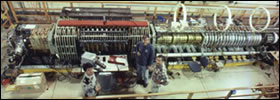 The Scientist: The Scientist:
Denis Visentin BSc (Hons)
School of Computing,
University of Tasmania
Denis is a native Launcestonian who moved to Hobart to do Engineering at the University of Tasmania. Before long he realised his real interest lay in physics, so he switched degrees after one year to instead do a Bachelor of Science.
“I’ve always been interested in the fundamentals, and found physics a fantastic way to understand the world,” Denis says.
Denis majored in physics in the third year of his science degree, and after Honours in fourth year he returned to Launceston to lecture in physics and electronics at the University, not to mention get married and have two children. Always keen to conduct more research, he commenced a PhD part-time in 2001, which soon became full-time.
“My PhD project is in computational physics and investigates numerical modelling of proposed controlled fusion reactors.” This involves developing theoretical models of confined plasmas under magnetic fields and performing computer simulations.
The results from Denis’s research will help to determine whether novel reactors are feasible and whether existing reactors in the USA can use the new technique.
“Fusion is ‘Big Science’, it’s a multi-billion dollar worldwide project and, if feasible, will revolutionise our world. It’s amazing to think that one researcher in Tasmania with a PC can make a valuable contribution. You don’t necessarily need huge resources to tackle these problems.”
When he completes his PhD, Denis hopes to do something radically different, applying the computer modelling skills he has developed in a new area of research. And stay in academia?
“Who knows? I enjoy passing on the expertise and inspiring the next group of scientists, but there are exciting opportunities in industry as well.”
More about the Work
Key words: Fusion, Plasma, Rotating Magnetic Field
RMF Current Drive in Confined Plasmas
Current fusion research involves using rotating magnetic fields in order to produce a workable fusion reactor for energy production. This project requires that a computer simulation be produced of a proposed fusion reactor using two rotating magnetic fields. It is hoped that this will support the feasibility of the reactor and convince experimenters in the U.S.A. to modify existing and future reactors to include a second rotating magnetic field.
Controlled Nuclear Fusion
A controlled nuclear fusion reactor for feasible energy production requires that a plasma (an extremely hot ionised gas, separated into electrons and ions) be contained for a significant time by a magnetic field. One method is to use an external rotating magnetic field (RMF) to drive a current in the plasma by entraining the electrons. One of the major problems with RMF current drive is the motion of the ions in the plasma. They will undergo collisions with the electrons and spin up, decreasing the current and the plasma equilibrium.
A proposed method of controlling the ion motion, called the Clemente scheme, is to provide a second RMF to drive the ions in the opposite direction to the electrons, thereby maintaining the plasma current.
The project involves producing a theoretical model of the plasma under the influence of two counter-rotating magnetic fields. A numerical simulation is then produced for this model in order to determine the feasibility (or otherwise) of the Clemente scheme.
Simulation Results
The Clemente scheme requires that the electrons ‘see’ one RMF and the ions ‘see’ the other. This weird behaviour has been shown theoretically to be the case if the collision frequency of the plasma is smaller than the frequency of the applied RMFs.
Initially the results from the simulation have shown that the Clemente scheme can work, where the electrons are driven by one RMF and the ions by the other, but only under specific starting conditions for the ion fluid. A completely new approach was tried, by allowing the frequency of the RMF to change. This allowed the reactor to be operational for much more general starting conditions.
Further work involves improving the model to allow the plasma to move freely, and hence test that special plasma configurations called Field Reversed Configurations (FRC) are confined by the two RMFs. It is hoped that the results from this research will be taken up by experimenters at the University of Washington, where the TCS (Translation Confinement and Sustainment) experiment is underway.

Websites:
Plasma Physics and Fusion Energy
https://ffden-2.phys.uaf.edu/introplasma11-17-98.pdf
Laboratory Plasmas
https://public.lanl.gov/alp/plasma/plasma_lab.html
School of Computing, University of Tasmania
https://www.comp.utas.edu.au
|
